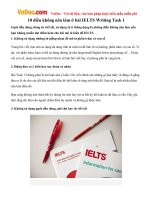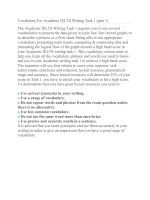IELTS WRITING TASK 1 pie chart
Bạn đang xem bản rút gọn của tài liệu. Xem và tải ngay bản đầy đủ của tài liệu tại đây (117.41 KB, 6 trang )
IELTS WRITING TASK 1: PIE CHART
A. GETTING TO KNOW
Read the sample answer and identify main parts in its outline.
Sample answer:
The pie charts illustrate the primary reasons that people came to and left the UK in 2007.
At first glance it is clear that the main factor influencing this decision was employment.
Having a definite job accounted for 30 per cent of immigration to the UK, and this figure
was very similar for emigration, at 29%. A large number of people, 22%, also emigrated
because they were looking for a job, though the proportion of people entering the UK for
this purpose was noticeably lower at less than a fifth.
Another major factor influencing a move to the UK was for formal study, with over a
quarter of people immigrating for this reason. However, interestingly, only a small
minority, 4%, left for this.
The proportions of those moving to join a family member were quite similar for
immigration and emigration, at 15% and 13% respectively. Although a significant number
of people (32%) gave ‘other’ reasons or did not give a reason why they emigrated, this
accounted for only 17% with regards to immigration.
Do Thi Thu Ha – Ielts Writing
Vocab learnt:
.......................................................................................................................................
.......................................................................................................................................
.......................................................................................................................................
.......................................................................................................................................
Sentence structures
1. Subject + account for/ make up + % of/ in N
Having a definite job accounted for 30% of immigration to the UK.
2. The percentage/ proportion of N + tobe + %
The proprotion of those moving to join a family member were 15%.
3. % N + Verb
A large number of people, 22%, also emigrated.
Vocab notes:
Fractions:
A large number of people
over a quarter of people
a small minority
A significant number of people
Do Thi Thu Ha – Ielts Writing
Percentage
Fraction
80%
four-fifths
75%
three-quarters
70%
seven in ten
65%
two-thirds
60%
three-fifths
55%
more than half
50%
half
45%
more than two fifths
40%
two-fifths
35%
more than a third
30%
less than a third
25%
a quarter
20%
a fifth
15%
less than a fifth
10%
one in ten
5%
one in twenty
Do Thi Thu Ha – Ielts Writing
Percentage
Qualifier
77%
just over three quarters
77%
approximately three quarters
49%
just under a half
49%
nearly a half
32%
almost a third
Percentage
proportion / number / amount /
majority / minority
75% - 85%
a very large majority
65% - 75%
a significant proportion
10% - 15%
a minority
5%
a very small number
B. PRACTICE
You should spend about 20 minutes on this task.
The pie charts show the electricity generated in Germany and France from all sources and
renewables in the year 2009.
Summarize the information by selecting and reporting the main features and make
comparisons where relevant.
Write at least 150 words.
Sample answer:
The four pie charts compare the electricity generated between Germany and France during
2009, and it is measured in billions kWh. Overall, it can be seen that conventional thermal
was the main source of electricity in Germany, whereas nuclear was the main source in
France.
The bulk of electricity in Germany, whose total output was 560 billion kWh, came from
conventional thermal, at 59.6%. In France, the total output was lower, at 510 billion kWh,
and in contrast to Germany, conventional thermal accounted for just 10.3%, with most
electricity coming from nuclear power (76%). In Germany, the proportion of nuclear power
generated electricity was only one fifth of the total.
Moving on to renewables, this accounted for quite similar proportions for both countries,
ranging from around 14% to 17% of the total electricity generated. In detail, in Germany,
most of the renewables consisted of wind and biomass, totaling around 75%, which was far
higher than for hydroelectric (17.7%) and solar (6.1%). The situation was very different in
France, where hydroelectric made up 80.5% of renewable electricity, with biomass, wind
and solar making up the remaining 20%. Neither country used geothermal energy.









